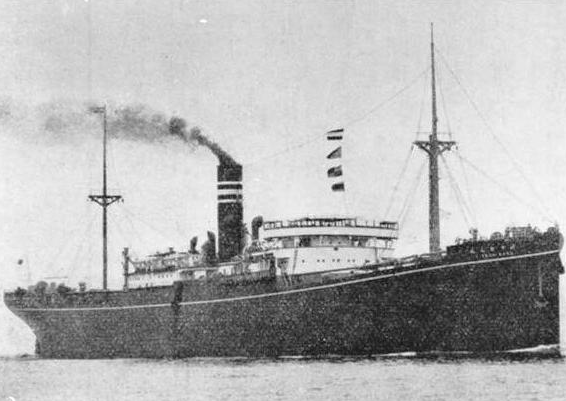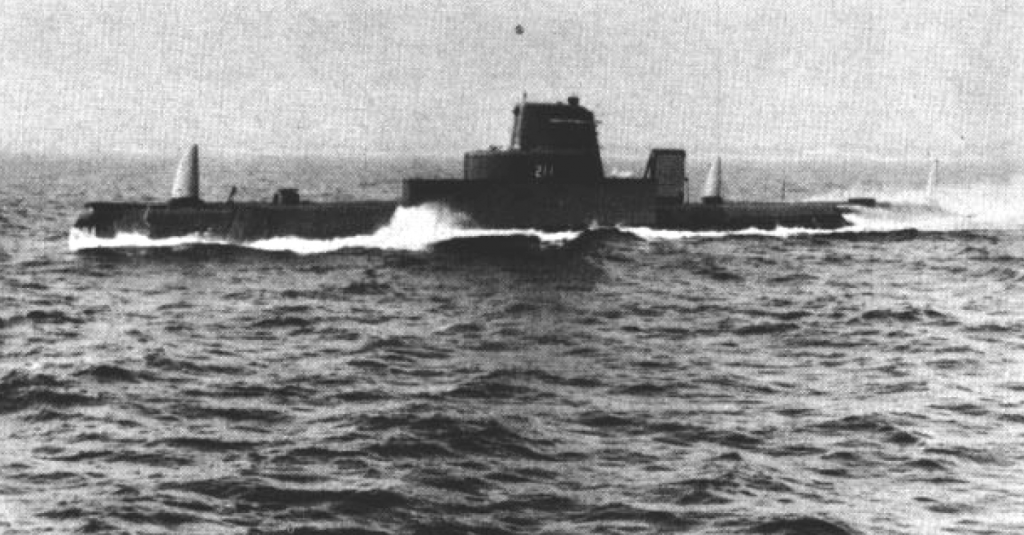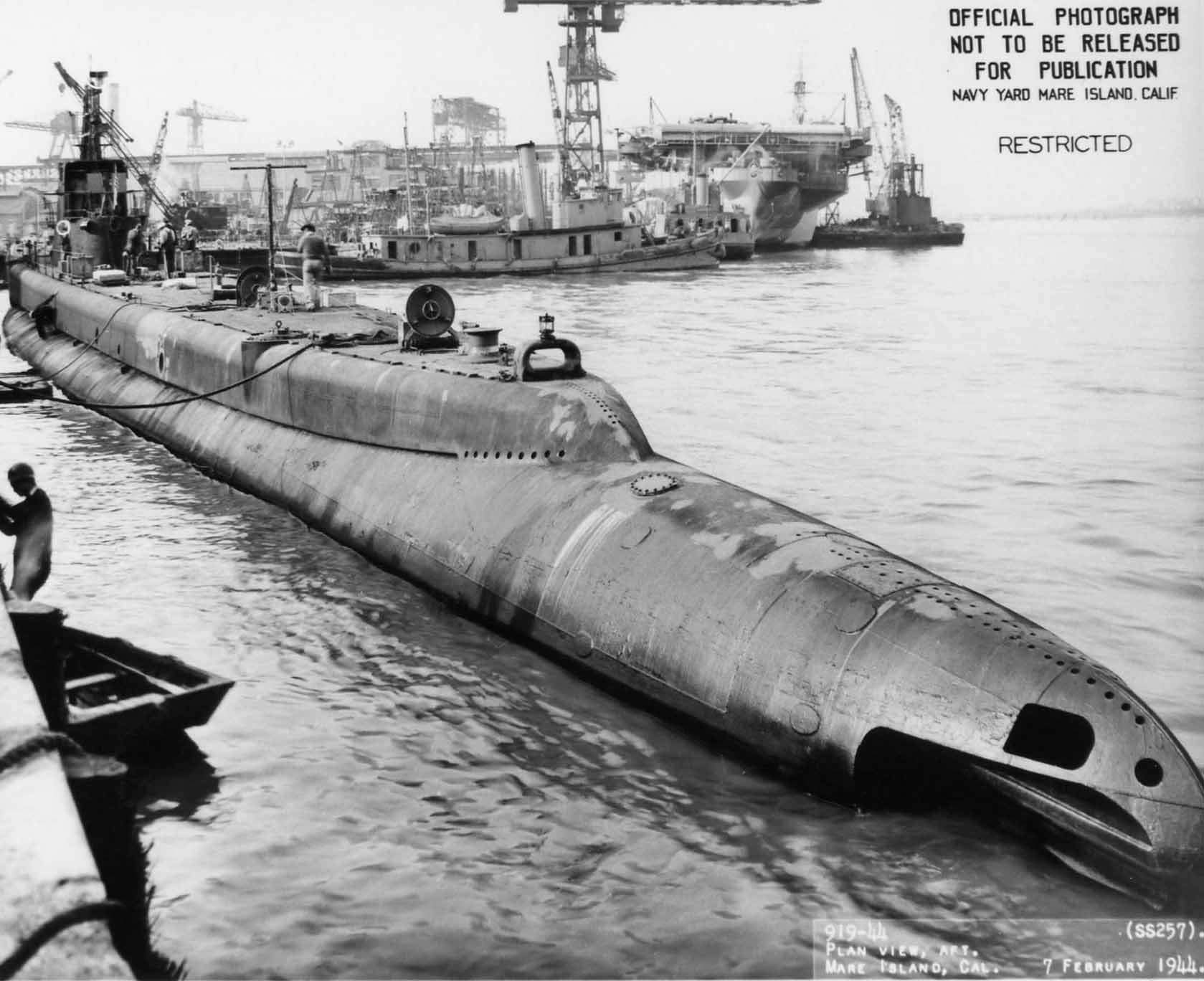On October 1, 1942, the USS Grouper torpedoed the Lisbon Maru, a Japanese ship traveling through the South China Sea. Unbeknownst to US military officials, the Lisbon Maru was carrying 1,816 British prisoners of war captured after the Battle of Hong Kong in December 1941. The ship began to sink, and Japanese troops evacuated, but not before battening down the hatches and trapping the POWs below deck. The prisoners finally broke through the hatch covers and attempted to escape. More than 800, however, perished in the disaster.
The USS Grouper was a Gato-class submarine and part of the Pacific Submarine Force in WWII. During her second patrol, the Grouper encountered the Lisbon Maru in the South China Sea. The 7,000-ton freighter turned armed troop ship was carrying some 800 Japanese troops and bore no flags or markings indicating that she also carried POWs. The prisoners had been captured at the Battle of Hong Kong, and many were sick and weak, having spent nearly a year in POW camps. They were being transported to provide slave labor to benefit Japan’s war effort.
The Grouper tracked the ship in the early morning of October 1, 1942, but bright moonlight prevented a surface attack. Instead, the Grouper dove and waited for the right moment. Just after 7:00 a.m., the sub fired three torpedoes at the Lisbon Maru. They all missed, but a fourth torpedo collided with the ship’s engine room at the stern. The Grouper raised the periscope and noted that the vessel had stopped and was returning fire. At 8:45 a.m., the Grouper’s crew reported that Lisbon Maru was listing. They also recorded that an enemy plane flying overhead dropped depth charges. The sub cleared the area, still having no idea Allied POWs were aboard the ship.
On board the Lisbon Maru, the POWs were kept below deck, in dark, overcrowded, sweltering holds and without access to food or water. Throughout the day, the ship continued to list, and by the evening, Japanese troops began evacuating, leaving a small contingent of guards to prevent an escape.
Conditions below the deck were deteriorating. Exhausted prisoners tried desperately to keep the holds from filling with water using hand pumps. The following morning, the ship lurched, and water began pouring in. The POWs panicked and attempted to break through the hatches. Lt. Hargraves Milne Howell finally opened a hatch, and prisoners rushed to the deck. The remaining Japanese guards fired upon the first men to surface, but they were soon outnumbered. Prisoners jumped in the water, hoping to swim to a nearby island, but many drowned. Nearby Japanese boats refused to rescue prisoners flailing in the water and even fired upon them.
A contingent of Chinese fishermen risked their lives to rescue the POWs and bring them back to shore. However, Japanese soldiers soon recaptured them. At least 825 men died. Survivors were rounded up and transported to other POW camps, where many later perished. Lt. Howell was sent to Fukuoka POW camp, where he remained until his liberation on September 20, 1945. For his efforts to help free the POWs stuck below deck, he was awarded the MBE (The Most Excellent Order of the British Empire) for gallantry.
To learn more about the Lisbon Maru tragedy, search Fold3® today.









Very tragic story, but far from unique! Just two weeks before the German U-Boat torpedoed the armed British passenger liner LACONIA in the South Atlantic. The ship was used as a troop transport, but also carried some 1.800 Italian POW’s to Britain. Hit by two torpedoes, the ship went down quickly. The vessel was neither marked nor officially announced as a POW transport. Polish guards locked up the prisoners below and opened fire when they panicked and some of them broke free. The German U-Boat commander was surprised to find Italians among the hundreds of survivors in the water. He rescued as much as he could and in his desperation sent an open radio message to all stations asking for help. However, there was no Allied reaction to this. So other U-boats ordered to the scene by the German U-Boat Command joined the rescue effort. Later Free-French vessels from Dakar in West Aftica arrived, saving more than 1000 persons. Before, the U-Boats, with numerous rescue boats in tow, were attacked by Allied aircraft including an American Liberator from Ascension Island. In order to prevent his U-Boat commanders from risking their U-Boats in future rescue operations, the C. in C. U-Boats subsequently issued the so-called LACONIA order. Post-war, the British accused him as war criminal for having deliberately ordered the killing of survivors. Vae Victis!
PS: The photographs of USS GROUPER is showing the boat in its post-war configuration, which was dominantly different from her war-time appearance.
Excellent comment! However the surface warships from Dakar were Vichy French, thanks
Thank you for correcting the misleading file photo… wrong time… wrong configuration. The image shows USS GROUPER in the redesignated AGSS-214 configuration… not in the wartime SS-214 configuration. GROUPER was then part of New London’s SUBRON 2, then working almost exclusively as a test platform for the New London based Naval Underwater Sound Labratory — as evidenced by the several SONAR arrays installed topside. That large installation just aft of the sail is what we called “The Colossus” – a SONAR array that contained 192 active transducers. In “63, GROUPER was my first SS qual boat as PO3. Thanks again. djp
As Axel stated, the picture is the USS GROUPER after the second world war. There plenty of pictures available showing her in WWII configuration.
Both sides made mistakes and also did unhumane deeds .
Where was the Grouper when all these men finally were freed from the hole. Could they not help rescue some of them?
Depth charges were being dropped and they did not know there were POWs on board.
Re-read the sentence about “USS Grouper having no idea POW’s were aboard the ship.”
My grandfather was one of those POWs. He never came home
I’m so sorry for your loss, Mandy, even if you never knew your grandfather…
Mine too x
sorry for your loss mandy. my uncle was also a POW on board. like your grandfather
uncle Terry also wss amongst those who never survived.
My question as well–where was the Grouper when the British POWs were jumping in the water in an attempt to save themselves??? They should have stayed in the vicinity. SMH
Rani,
As a former sub sailor, I can tell you that, not knowing that the ship was carrying POW’s, as son as they were confident that it was sinking they left the area quickly. This was because they expected the ship would radio what had happened and aircraft and other submarine hunters would converge on the location and search for the sub that had damage/sunk the freighter. The farther that they could get from the location of the attack the safer that they would be. Submarines of that era could not move quickly under water for very long, nor could they stay submerged for very long, so if they were located there was a very big probability that they would be sunk. Very, very few survived the loss of their boat. The submarine service in WWII had the highest causality rate in the US Navy.
Did you not read the part that said, they didn’t know about the POW’s and were depth charged, so they left the area?
Hi I’m the Genealogist who did the research for the recent film about the sinking, you can find some of the things I found out through the connections in my blog here:
http://timedetectives.blog/2023/08/18/the-sinking-of-the-lisbon-maru-the-828-unforgotten/
Thank you for the excellent information
The Grouper perhaps could have rescued a few, but as a sub, and far from base, it would not have had room (and perhaps supplies) to handle very many.
A Doctor’s War by Aidan MacCarthy also gives an account of being torpedoed while a prisoner in a japanese ship.
A very interesting man with a fantastic story of survival. PBS UK often run a documentary about his life and a sword that was given to him by his Japanese Camp Commander. (A Doctors Sword)
Aidan MacCarthy was a RAF doctor who survived the evacuation of Dunkirk in 1940 and the Atomic Bombing of Nagasaki in 1945.
In 1941 at Honington air base in Suffolk, England where he was stationed and was awarded the George Medal for bravery for rescuing a crew from a burning aircraft.
A year later he was sent to north Africa and then to the Far East, where he was captured by the Japanese at Java. His prison ship was torpedoed by the Americans, and he spent 24 hours in the water before being rescued by another prison ship which took him to the Japanese mainland. Only 30 of the1,000 men on board the ship survived.
He married Kathleen Wall from Co. Galway in Westminister in 1948. He died on the 11th October 1995 at the age of 82 at home in Northwood Middlesex.
His widow Kathleen MacCarthy, aged 97, died on the 21st March 2013 in Castletownbere.
My dad served on the Grouper, and yes, the picture is a later version used for experimental radar installations. He was not on board when this happened, I am sure they all felt really bad to find out later. They had no idea at the time.
Most of us who’ve served understand the rational morality of war. You don’t risk one of 92 subs, If I remember correctly the number, on the possibilities. In war time there are many ways to die. Some are truly heartbreaking. The USS Grouper destroyed a Japanese ship hindering the war efforts of Japan. That is a win, and the fact that they got away safely is also a win. If they had been able to do more, they would have. This bare rationale is the reason that we should not make war if we are able to refrain.
Proud to be USN, and sad that I lost a shipmate. Glad I survived.
MBE (The Most Excellent Order of the British Empire) only if Bill and Ted wrote it.
Member of the Order of the British Empire ( MBE )
The Most Excellent Order of the British Empire is a British order of chivalry, rewarding contributions to the arts and sciences, work with charitable and welfare organisations, and public service outside the civil service. Wikipedia
Title: Officer of the Order of the British Empire cabinetoffice.gov.uk
Awarded for: Prominent national or regional achievements
Established: 1917
Grades: Knight/Dame Grand Cross (GBE); Knight/Dame Commander (KBE/DBE); Commander (CBE); Officer (OBE); Member (MBE)
Motto: For God and the Empire
Next (higher): Royal Victorian Order
Status: Currently constituted
A similar incident occurred December 15, 1944. The transport ship Oryoku Maru, “loaded with American prisoners” (survivors of Corregidor and Bataan), en route to Japan, when sunk by U.S. submarines.
My grandad was sadly one of the prisoners of war on this ship and we are trying to find out as much as can about this
A well written precis of a piece of history I am very familiar with. My father was one of the survivors of the Lisbon Maru. After escaping from the ship and swimming for about 11 hours toward a group of islands he was eventually recaptured. He spent the remainder of the war in Kobe, Japan as a POW.
Thousands of US and British POWs were in the holds of Hell Ships. They were transported across the Pacific as labor was needed, and became the Japanese slave laborers.
The Allies knew there were POWs aboard those freighters but feared the Japanese would, then, know their communication code was broken. So the Allies fired on the Hell Ships. Thousands of POWs were killed.
In the holds of the Hell Ships human dignity and decency was destroyed. The desperation inside the holds men drank their own urine and, also, slit their wrists for blood to drink. Some cannibalized those deceased. A man I interviewed said, “Americans killed Americans, in order to survive another day on a hell ship.”
The movie Unbroken. Louie Zamparini walks down a plank off the hell ship. That part of the could not be included as the Hell Ship saga needs its own movie. The atrocities that occurred on them was horrendous for the military personnel aboard.
My Uncle Francis Gordon Hardy was a POW on board and perished
My Uncle Captain Joseph Elmer Terry of 301st Field Artillery in the Philippines was on the Arisan Maru when it was sunk believed by the USS Snook on October 24, 1944. Of the 1800 prisoners only 5 survived.
The USS Squalus began a test dive that went wrong in 1939. 26 crew in the aft section were lost, but 33 in the forward areas survived, even as Squalus sank in 240′ of water. Her sister ship, Sculpin, located her on the bottom. For the 1st time in history, the McCann Rescue Chamber was used, and over 13 hours, rescued the 33 crew men in the forward section. Squalus was raised, repaired and recommissioned as Sailfish. Both went to war after Pearl Harbor.
On Sculpin’s 9th war patrol, she was damaged and forced into a surface gun action with a Japanese destroyer. She was sunk, but the Japanese rescued 41 survivors. They were embarked on two aircraft carriers returning to Japan. Sailfish (ex-Squalus) on her 10th war patrol, found and sunk the carrier Chuyo carrying 21 of the Sculpin’s survivors. Only one survived the sinking and the Japanese POW camps. It wasn’t until after the war ended, that it was found that the Sculpin, saved the Squalus, who later sunk the carrier transporting Sculpin survivors.
Hi, we were genealogists on this story for the film (to be released soon) and information can be found on our website http://www.angliaresearch.co.uk. We traced many of the relatives of the prisoners on board the Lisbon Maru and attended the film premiere for the relatives in London at the BFI.
Hi, thank you for relating this very sad story. My grandfather, Lance Corporal Charles Henry Hatfield (no. 6200350) (born Charles Light), was one of the POWs on board the Lisbon Maru. He managed to escape from the hold and his last words to his fellow soldiers as he prepared to swim for his life were “I’ll race you to the islands over there”. Unfortunately, the Japanese soldiers who had stayed behind were picking off the POWs in the water. They shot my grandfather and he perished in the sea. For quite a few years I’ve been trying to get a photograph of him, I’ve never seen his face and neither did his daughter (my mother). If anyone out there knew him, or where I could get a photo of him, I’d be eternally grateful. By the way, in no way do I blame the crew of the USS Grouper. The Japanese were supposed to mark the Lisbon Maru to show that it was carrying POWs. It didn’t, which is a war crime. The USS Grouper was just doing its job.
Similarly, the Montevideo Maru was reported to be carrying over 1000 mainly Australian prisoners of war to Japan when it was sunk off the coast of the Philippines on July 1, 1942 by the USS Sturgeon. Any prisoners who survived the sinking apparently died not long afterwards.
“Даркнет: Тайный Мир Интернета и Товары без Ограничений”,blacksprut darknet Интернет является местом, где мы можем найти практически всю информацию и товары, которые мы можем себе представить. Однако существует скрытая сторона этой вселенной, известная как “даркнет” или “темная сеть”. Даркнет представляет собой часть интернета, скрытую от обычных поисковых систем и доступную только через специальные программы, такие как Tor. Это место, где анонимность и безопасность играют важную роль, и где можно найти разнообразные товары и услуги, как легальные, так и незаконные. В этой статье мы рассмотрим, что такое даркнет и какие товары там можно купить.Что такое даркнет?Даркнет – это часть интернета, которая не индексируется обычными поисковыми системами, такими как Google или Bing. Для доступа к ней требуются специальные программы для анонимизации, такие как Tor (The Onion Router), которые маскируют ваш IP-адрес и делают вас анонимными. Это делает даркнет привлекательным для людей, которые хотят обойти цензуру, оставаться анонимными или заниматься незаконными деятельностями.Что можно купить в даркнете?В даркнете можно найти широкий спектр товаров и услуг. Некоторые из них легальны и полезны, в то время как другие находятся в серой или незаконной зоне. Вот некоторые из категорий товаров и услуг, доступных в даркнете:Наркотики: Даркнет известен своими “наркорынками”, где можно найти наркотики различных видов и качества. Это одна из самых опасных сторон даркнета, так как встречаются мошеннические продавцы.Оружие и боеприпасы: Несмотря на незаконность, в даркнете можно найти продавцов, предлагающих огнестрельное оружие и боеприпасы.Краденые данные и информация: Здесь можно приобрести украденные кредитные карты, персональные данные и другую конфиденциальную информацию.Фальшивые документы: На даркнете можно заказать фальшивые паспорта, водительские удостоверения и документы.Услуги хакеров: Многие хакеры и киберпреступники предлагают свои услуги взлома аккаунтов, веб-сайтов и другие атаки на информационную безопасность.Легальные товары и услуги: На даркнете также можно найти легальные товары и услуги, такие как книги, программное обеспечение, хостинг-услуги, форумы и многое другое.Риски и опасности даркнетаХотя даркнет может предоставлять доступ к анонимным ресурсам и услугам, он также сопряжен с рисками. Во-первых, сделки в даркнете часто совершаются с использованием криптовалют, что делает их трудными для отслеживания и расследования. Во-вторых, многие продавцы мошенничают, и покупатели могут столкнуться с потерей денег или даже стать жертвами преступлений.Более того, участие в незаконных деятельностях в даркнете может иметь юридические последствия, так как оно нарушает законодательство многих стран.ЗаключениеДаркнет представляет собой сложный и двойственный мир, который привлекает разных людей по разным причинам. Он предоставляет доступ к различным товарам и услугам, но также сопряжен с серьезными рисками и потенциальными негативными последствиями. Важно помнить, что деятельность в даркнете должна быть законной и этичной, и всегда следует соблюдать законы своей страны.